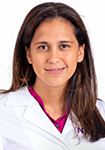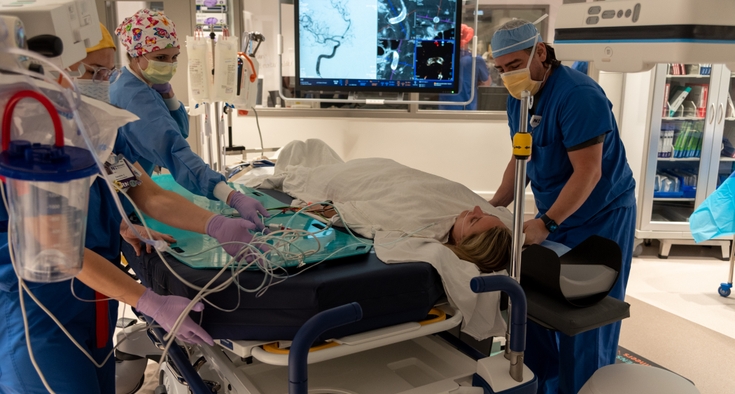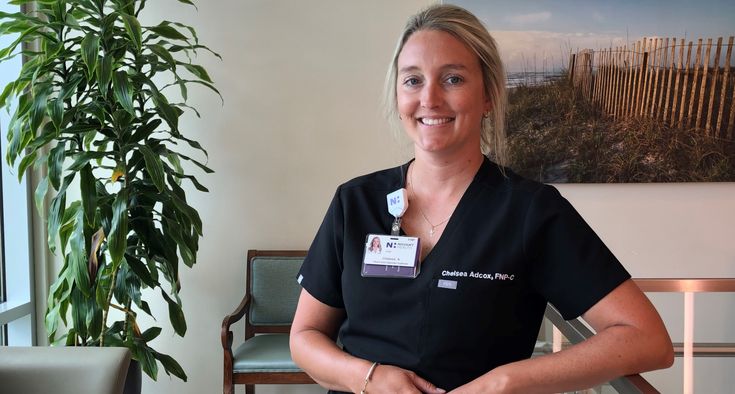No one makes an appointment to see Dr. Amanda Pardon or Dr. Jafar Hashem.
Their patients in the neurocritical care unit at Novant Health New Hanover Regional Medical Center had no idea they’d need a neurointensivist.

“We respond to sudden neurologic emergencies,” Hashem explained. “Someone is living their daily life, and out of nowhere, suffers an acute stroke or seizures. Our patients weren’t expecting to find themselves in an ICU.”
Yet for anyone who’s suffered a stroke, aneurysm, seizure or other neurological event, there’s no better place in the region to be treated. New Hanover Regional Medical Center’s neurocritical care unit is its own high-functioning entity within the Novant Health Neurosciences Institute - New Hanover – separate from the general medical, surgical or cardiac ICUs – with 10 beds, state-of-the-art equipment and doctors trained in both neurology and critical care medicine.
There are some similarities to other ICUs, although Hashem said an ICU devoted to patients with neurological disorders is “probably a little quieter, although no ICU is devoid of beeping and alarms.”
Some patients are on life support, though not all are. Some can talk but may be at a high risk of decline that could diminish their outcomes and quality of life.
Noticing – and responding to – those changes leads to better outcomes. This is a high-risk patient population, and the care team is committed to minimizing those risks.
“Similar to other ICUs, our patients are at risk for complications, although in different ways,” Hashem said. These include recurrent stroke, brain bleeding or seizures, which can lead to secondary brain injury.

“Our focus is on close, careful monitoring, which allows us to catch any changes, even subtle ones, early,” Pardon said.
New Hanover Regional Medical Center’s facility has the latest equipment with futuristic-sounding names like “transcranial Doppler” and “intracranial pressure monitor.” There’s also a video electroencephalogram (EEG) that can continuously monitor brain activity and a portable CT scanner for patients not well enough to be moved to the radiology department for a scan. The portable scanner can come to them.
But monitoring isn’t just left to machines. Both Pardon and Hashem praise the nurses for the crucial role they play.
“Nurses everywhere work hard and take on active roles,” Hashem said. “But in our ICU, there’s the added role of neurologic assessments. Nurses have to stay tuned, on an hour-by-hour basis, to subtle neurologic changes. This isn’t something that's read by a machine. If a nurse notices a change, there could be risk of secondary brain injury, and we’ll need to intervene.”
The team is focused on monitoring other organs besides the brain, too. Heart dysfunction can occur as the result of a stroke, so the neuro ICU team monitors patients’ respiratory and cardiac systems.
“We have to be concerned with all the organ systems to preserve harmony in the body so the brain can thrive and recover,” Hashem said.
Conditions treated
Unlike other ICUs, there’s often very little visible trauma among neuro ICU patients. Most patients haven’t been in an accident or broken a bone; they’re there because they’ve suffered a stroke.
- The most common one is an acute ischemic stroke, which is when a blood clot forms in the brain and blocks an artery. That kind of stroke would be treated harmoniously by a neurologist and endovascular neurosurgeon, and would entail an intravenous thrombolysis (IVT) – a medication that dissolves the clot – and/or mechanical thrombectomy, a minimally invasive procedure where a surgeon inserts a catheter, usually going in through the wrist or groin, and guides it to the blood clot in the brain.
- The second most common condition the New Hanover neurointensivists see is hemorrhagic – or, the bleeding type of – stroke.
- And the third is subarachnoid hemorrhage, a type of stroke usually linked to a ruptured aneurysm.
Novant Health New Hanover Medical Center, along with Novant Health Presbyterian Medical Center in Charlotte and Novant Health Forsyth Medical Center in Winston-Salem, is a certified comprehensive stroke center. These centers are known for having a highly trained medical staff and, beyond that, they’re required to perform a minimum number of specific advanced procedures to treat brain aneurysms and ischemic strokes.
New Hanover Regional Medical Center’s certification also means that neurology patients might have the option of being part of large, and potentially groundbreaking, clinical trials that are advancing the neurocritical care field.
Other conditions treated in the neuro ICU are:
- Postoperative or perioperative cases, mostly brain tumors and endovascular procedures
- Seizures and status epilepticus (that’s a seizure lasting more than five minutes)
- Neuro infections (such as encephalitis or meningitis)
- Neuromuscular weakness, such as Guillain-Barre syndrome (a rare autoimmune disorder where the body's immune system attacks the peripheral nerves) and myasthenia gravis (an autoimmune disorder that causes weakness in the skeletal muscles – the muscles we’re able to control).
‘We fight hard’
Neuro ICU patients have serious conditions, and the people taking care of them are seriously trained.
Pardon and Hashem are certified in neurology as well as neurocritical care. That means they did a four-year neurology residency plus a two-year neurocritical care fellowship. Hashem also completed a second fellowship in critical care EEG and epilepsy.
Both of New Hanover’s neurointensivists point out that they don’t care for patients alone. It’s a group effort, and they praise the multidisciplinary team that includes neurosurgeons; highly trained advanced practice providers; a specialized neuro pharmacist; critical care nurses; various therapists, including physical, occupational and respiratory therapists; case managers; EEG techs and ultrasound techs.
Are there common characteristics most neurologists share?
Pardon said all are critical thinkers. Hashem said they’re all inherently detail oriented. “We have to be able to pick up on small changes and understand what those mean,” he said.
“I hesitate to use the word ‘nerd’,” Hashem said, “but many neurologists spend our free time looking at scientific data related to our field – and actually enjoying that. We’re always looking for better answers.”
They’re analytical, but in the ICU, they don’t have the luxury of taking their time to ponder. Neurologists have a motto: “Time is brain.”
If a stroke is suspected, every second matters. “Once that stroke code is activated,” Hashem said, “it’s on.”
He’s referring to the streamlined protocols all certified stroke centers must have in place that ensure patients are diagnosed and treated as quickly as humanly possible.
“We work by the clock,” Hashem said. “Everything we do – the imaging, the thrombectomy, all of it – we do as fast as possible. The essence of everything we do is precision and speed. That maximizes the chances for a meaningful recovery. Whenever there’s a chance for meaningful improvement or any path forward, we take it seriously. We fight hard for every inch of recovery.”
The human connection
Many neuro ICU patients aren’t able to talk. So, the care team communicates often with their families. And they get to know those families well. The average ICU stay is two or three days, although some patients are there for four or five weeks. And some family members spend the night in the ICU with their loved one.
“We get to know them on a first-name basis,” Pardon said. “What we love most is when patients come back to tell us how they’re doing. One patient, who’d been really sick with meningitis, was with us for about two weeks. His hobby is making birdhouses, and he made one for all of us. We were all so touched.”
The staff understands that communication and compassion matter as much as experience and technology. So, the neuro ICU has more than high-tech gadgetry going for it. “The human connection is so important,” Hashem said. “We work closely with patients’ families, and we empower them and involve them every step of the way. They aren’t just bystanders; they’re our partners.”
When most patients leave ICU care, they’ll go to a neurology step-down unit. But Pardon said, “A good number of our stroke patients now go home from the ICU. Thrombectomies can make such a difference for stroke patients, that some of them are able to go home – with a plan to begin physical therapy – the next day.”
Patients who’ve been sick enough to land in the ICU will likely require rehabilitation and possibly ongoing care, Hashem said, adding, “it’s not uncommon for patients to have fast improvement and go home within a day or two. Those are the success stories we really thrive on.”
When patients come to the neuro ICU, it’s a scary and uncertain time. But the care team, led by Hashem and Pardon, aims to take away the fear and return them to their lives. With all the years of study, their goal for patients and their families comes down to something simple – something that isn’t taught enough in medical school.
“Our aim,” Hashem said, “is to restore hope, provide a path for recovery and humanize care as best we can.”













